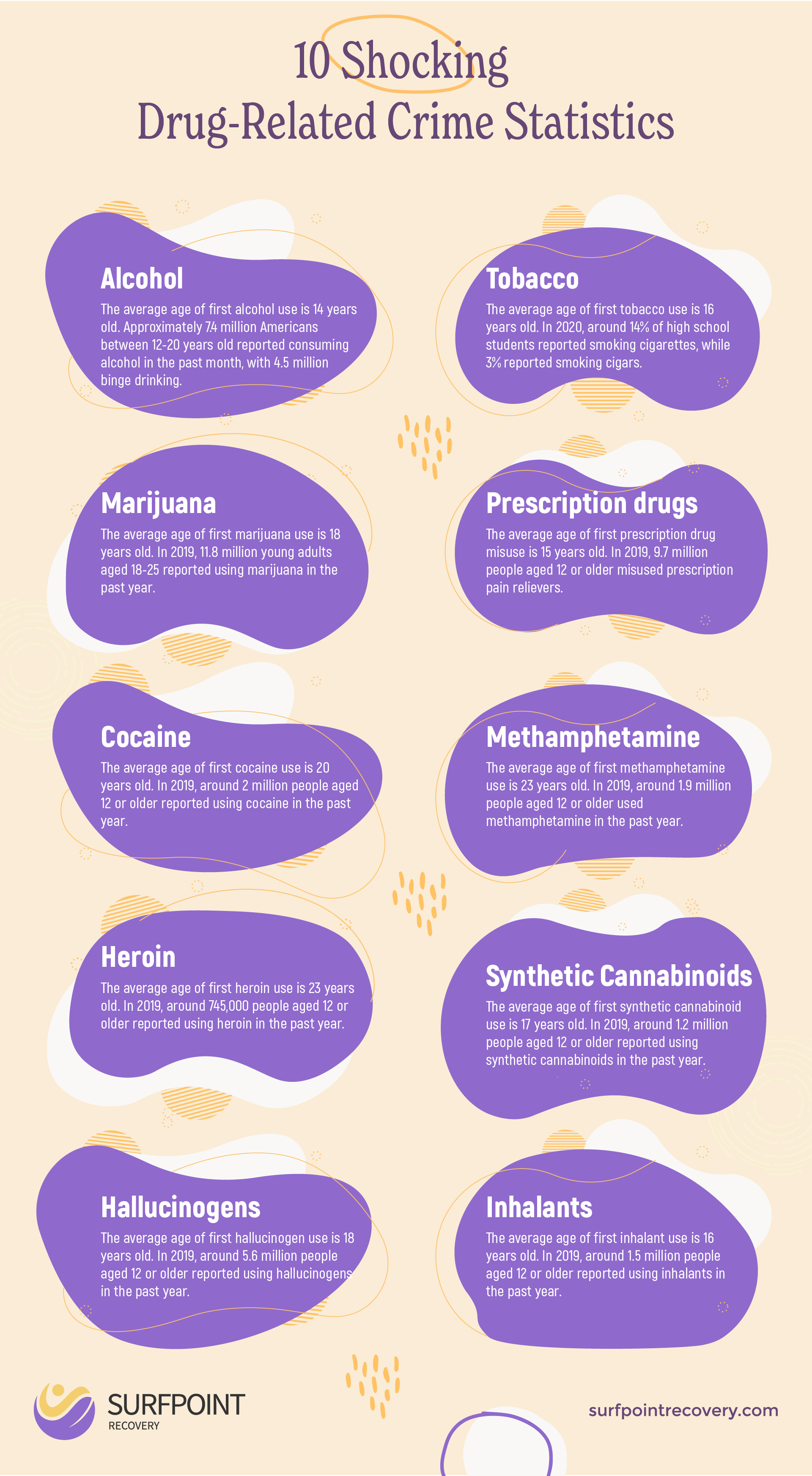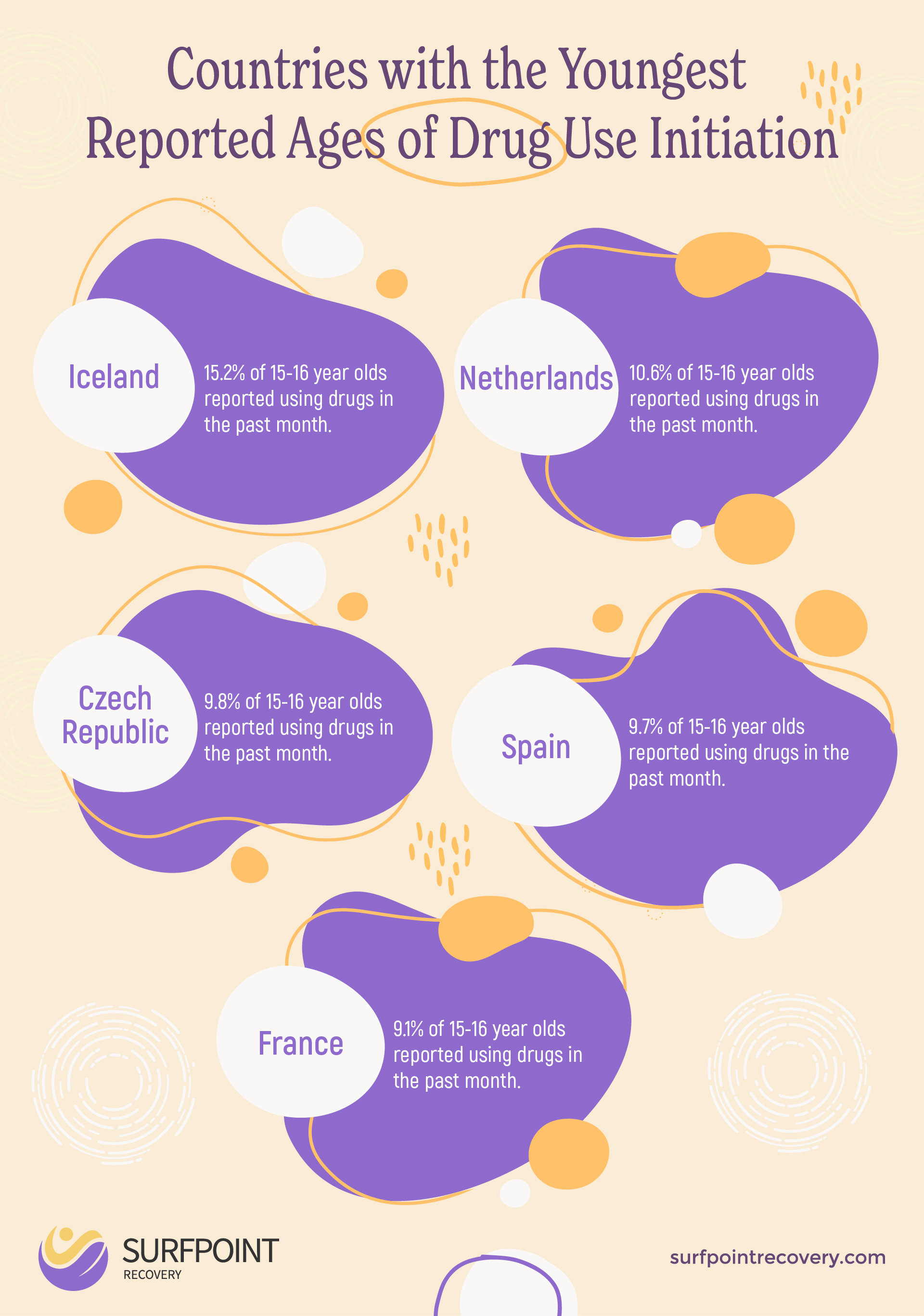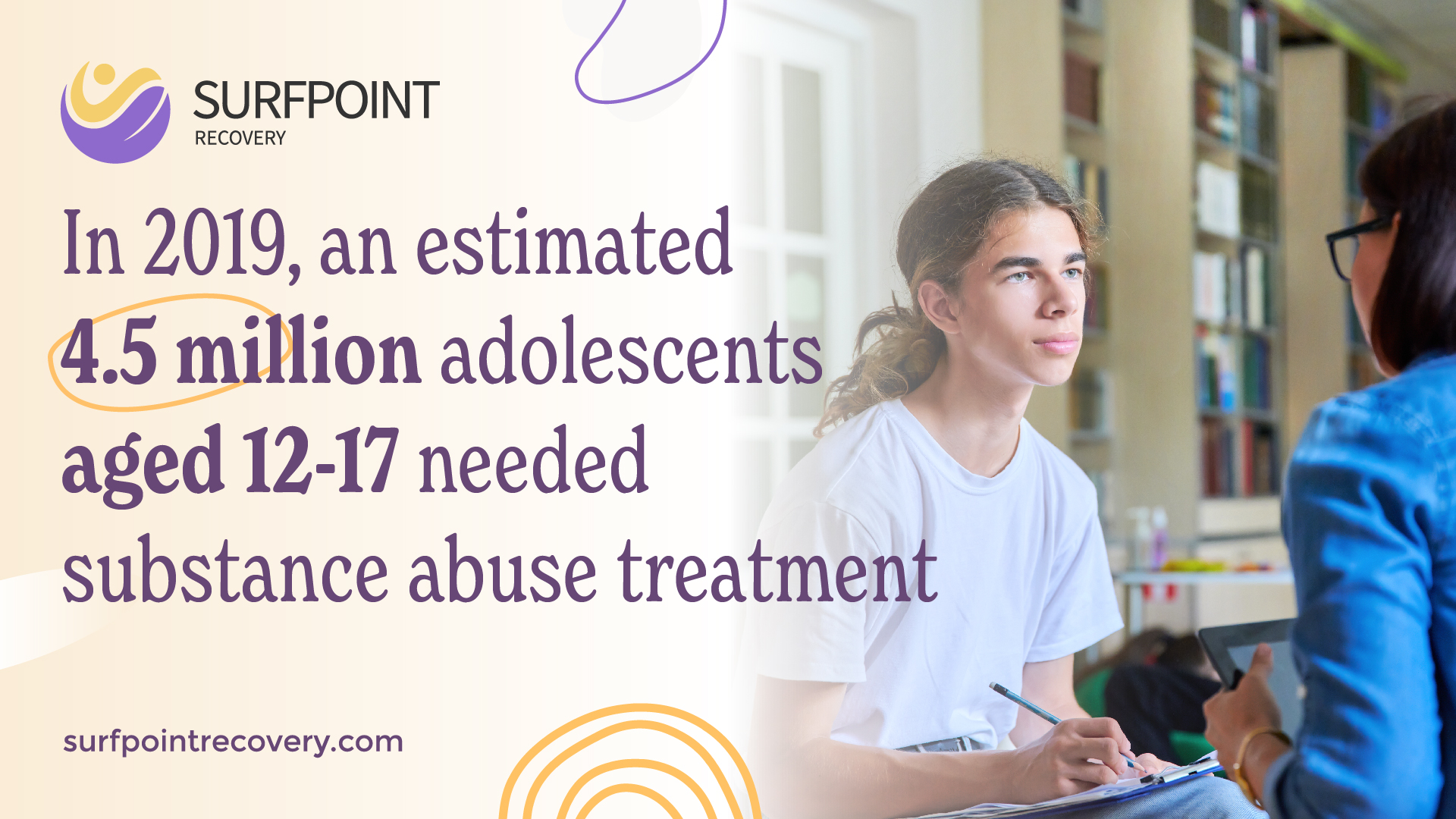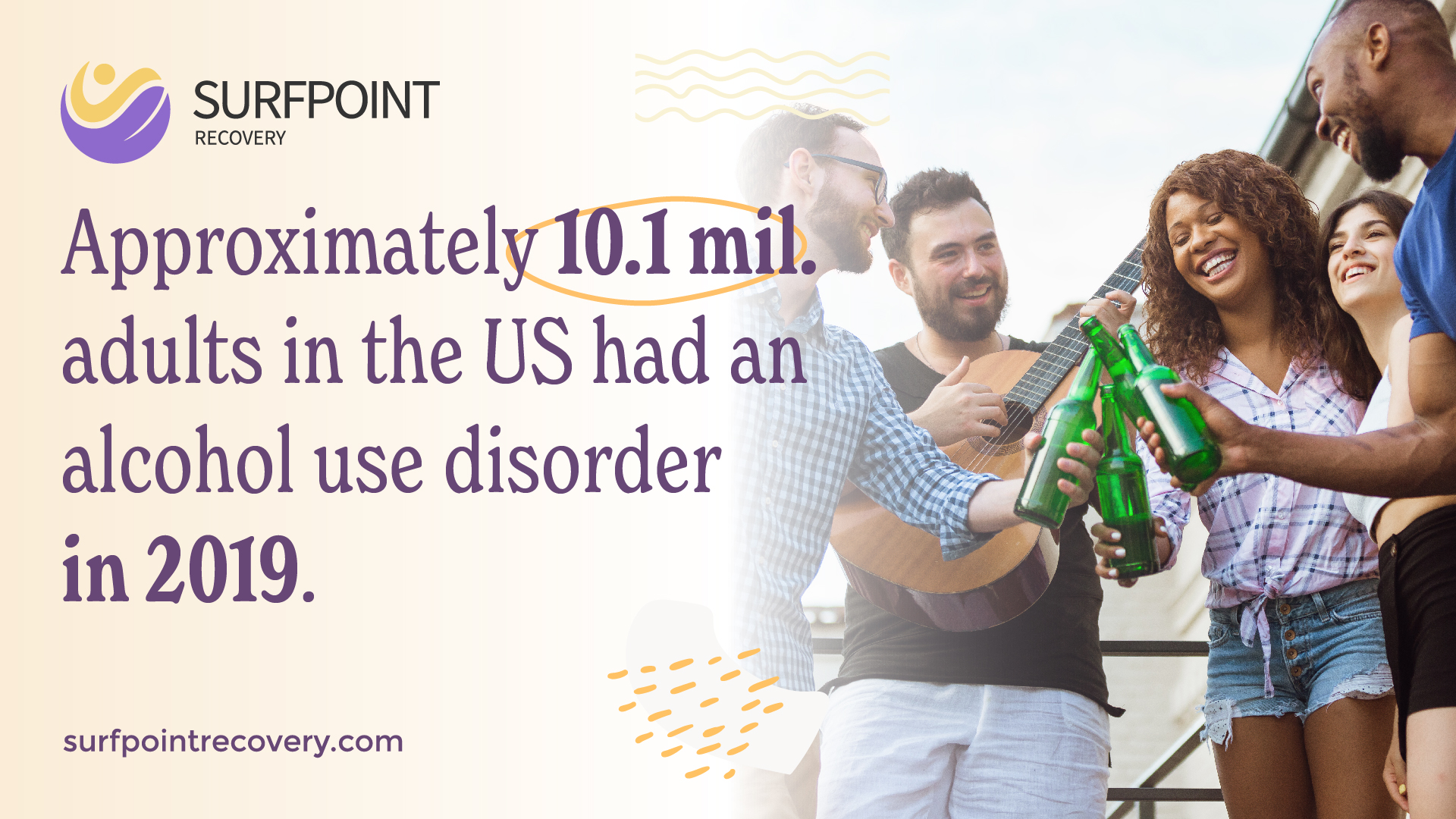
Average Age of Substance Abuse Statistics

- Alcohol: The average age of first alcohol use is 14 years old. Approximately 7.4 million Americans between 12-20 years old reported consuming alcohol in the past month, with 4.5 million binge drinking.
- Tobacco: The average age of first tobacco use is 16 years old. In 2020, around 14% of high school students reported smoking cigarettes, while 3% reported smoking cigars.
- Marijuana: The average age of first marijuana use is 18 years old. In 2019, 11.8 million young adults aged 18-25 reported using marijuana in the past year.
- Prescription drugs: The average age of first prescription drug misuse is 15 years old. In 2019, 9.7 million people aged 12 or older misused prescription pain relievers.
- Cocaine: The average age of first cocaine use is 20 years old. In 2019, around 2 million people aged 12 or older reported using cocaine in the past year.
- Methamphetamine: The average age of first methamphetamine use is 23 years old. In 2019, around 1.9 million people aged 12 or older used methamphetamine in the past year.
- Heroin: The average age of first heroin use is 23 years old. In 2019, around 745,000 people aged 12 or older reported using heroin in the past year.
- Synthetic cannabinoids (Spice/K2): The average age of first synthetic cannabinoid use is 17 years old. In 2019, around 1.2 million people aged 12 or older reported using synthetic cannabinoids in the past year.
- Hallucinogens: The average age of first hallucinogen use is 18 years old. In 2019, around 5.6 million people aged 12 or older reported using hallucinogens in the past year.
- Inhalants: The average age of first inhalant use is 16 years old. In 2019, around 1.5 million people aged 12 or older reported using inhalants in the past year.
Marijuana Use Among Students Statistics
- In 2019, approximately 43% of high school students in the United States reported using marijuana at least once in their lifetime.
- Around 22% of high school students reported using marijuana in the past month.
- Among high school seniors, 35% reported using marijuana in the past year.
- In states where medical marijuana is legal, high school students are more likely to report using marijuana compared to states where it is not legal for medical use.
- According to a survey conducted by Monitoring the Future in 2020, about 6% of high school seniors reported daily use of marijuana.
- In 2019, around 46% of male high school students reported using marijuana
- 40% of female high school students.
Impact of Substance Abuse on Young People's Academic Performance
- Students who use drugs or alcohol are more likely to miss school, with up to 32% of high school students reporting missing classes due to substance use.
- In 2019, around 16% of high school seniors reported using marijuana daily. These students were found to have lower GPAs and were less likely to graduate from high school on time compared to non-users.
- Substance abuse can also lead to disciplinary action and suspension from school, further impacting academic success. In 2019, almost 74% of public schools reported at least one incident involving drugs or alcohol on campus.

Countries with the Youngest Reported Ages of Drug Use Initiation

- Iceland: 15.2% of 15-16 year olds reported using drugs in the past month.
- Netherlands: 10.6% of 15-16 year olds reported using drugs in the past month.
- Czech Republic: 9.8% of 15-16 year olds reported using drugs in the past month.
- Spain: 9.7% of 15-16 year olds reported using drugs in the past month.
- France: 9.1% of 15-16 year olds reported using drugs in the past month.
Countries with Older Reported Ages of Drug Use Initiation

- United Arab Emirates: Only 1.3% of 15-16 year olds reported using drugs in the past month.
- South Korea: 1.4% of 15-16 year olds reported using drugs in the past month.
- Israel: 1.8% of 15-16 year olds reported using drugs in the past month.
- Japan: Only 2.1% of 15-16 year olds reported using drugs in the past month.
- Saudi Arabia: Only 2.2% of 15-16 year olds reported using drugs in the past month.
Drug Abuse Deaths Among Teenagers and Young Adults Worldwide
- In the United States, drug overdose is the leading cause of injury death among young adults aged 25-34.
- According to the World Health Organization, approximately 450,000 people die each year due to drug use. Of those deaths, 168,000 are attributed to drug use disorders in people aged 15-64 years old.
- In Europe, around 8% of all deaths among young adults aged 15-39 years old are attributed to drug use disorders.
- In Australia, there were 1,740 drug-induced deaths in 2018 with the majority being between the ages of 30 and 39.
- In Canada, there were over 16,000 opioid-related deaths from January 2016 to December 2019 with young adults aged 20-29 representing a significant proportion of those deaths.
- In South Africa, approximately one-third of all admissions for substance abuse treatment were for individuals under the age of 20.
- In India, it is estimated that around two million people inject drugs and that HIV prevalence among this population is as high as 24%.
![Teenage Drug Use Statistics [2023]: Data & Trends on Abuse](https://assets-global.website-files.com/64c19642205c05a52b9228aa/64e590b6368d01912de58595_youth-who-used-opioids-in-the-past-year.png)
How Many Young People Received Treatment?
- In 2019, an estimated 4.5 million adolescents aged 12-17 needed substance abuse treatment, but only around 6.3% received it.
- Among young adults aged 18-25 who needed substance abuse treatment in the past year, only around 13.4% received it.
- In Canada, among those aged 15-24 who reported needing substance abuse treatment in the past year, only around 10% received it.
- In Australia, in the period between July 2018 and June 2019, there were over 24,000 treatment episodes for people aged between 10 and 19 years old.
- According to a survey conducted by SAMHSA in the United States, of those who received substance abuse treatment in the past year, around one-third were under the age of 18.

Adolescent Substance Abuse Facts
- About 1 in 7 high school students in the United States reported binge drinking (consuming five or more drinks on one occasion) within the past month.
- In 2019, approximately 3.6% of high school students reported using cocaine at least once in their lifetime.
- According to a survey conducted by the National Institute on Drug Abuse, around 5.4% of high school seniors reported misusing prescription drugs within the past month.
- In 2020, about 13.6% of high school students reported vaping nicotine within the past month.
- Approximately 5.8% of high school students reported using synthetic cannabinoids (such as Spice or K2) within the past year.
- In a study conducted by SAMHSA, it was found that around 60% of adolescents who received substance abuse treatment had used marijuana as their primary substance.
- According to the CDC, around 1 in 5 high school students have ridden in a car with someone who had been drinking alcohol.
- In a survey conducted by Monitoring the Future, around 14% of high school seniors reported using e-cigarettes within the past month in 2020.
- Around 2.3 million adolescents aged between 12 and 17 used an illicit drug within the past month according to NSDUH data from 2019.
- In a study published by Pediatrics, it was found that adolescents who use social media for longer periods are more likely to report substance use compared to those who spend less time on social media.

![NCDAS: Substance Abuse and Addiction Statistics [2023]](https://assets-global.website-files.com/64c19642205c05a52b9228aa/64e590d156c9551efa17ee64_percentage-of-adults-in-the-us-who-felt-select-substances-were-a-serious-problem-in-their-community-in-2018.png)
Substance Abuse Statistics
- In the United States, approximately 20 million people aged 12 or older had a substance use disorder in 2019.
- About 7.5 million people in the United States struggled with both a substance use disorder and a mental health condition in 2019.
- In 2020, around 14% of adults in the United States reported using illicit drugs within the past year.
- Approximately 10.1 million adults in the United States had an alcohol use disorder in 2019.
- In Europe, it is estimated that around one-quarter of all deaths among young adults aged 15-39 years old are due to drug use disorders.
- According to a survey conducted by the National Institute on Drug Abuse, around 8% of high school seniors reported using hallucinogens within their lifetime in 2020.
- In Canada, approximately one-third of all treatment admissions for substance abuse were for individuals under the age of 30.
- According to NSDUH data from 2019, about half of young adults aged between 18 and 25 who needed substance abuse treatment did not receive it.
- In Australia, around two-thirds of people who sought treatment for drug-related issues cited amphetamines as their primary drug of concern.

FAQs
What does "average age of substance abuse" mean?
The average age of substance abuse refers to the age at which people typically begin using a particular drug. This statistic can be helpful in understanding trends in drug use and identifying risk factors for substance abuse.
Why is it important to know the average age of substance abuse?
Well, understanding this information is key to developing effective prevention strategies and addressing the root causes of drug use. Substance abuse can have severe consequences on an individual's physical and mental health, as well as their social and economic well-being.
By identifying when individuals are most likely to start using drugs, we can pinpoint the risk factors that lead to drug use and create targeted prevention efforts.
For example, if we find that teenagers are more prone to drug use than adults, we can focus on educating parents, teachers, and healthcare providers to help them identify and address early signs of drug use among young people.
Moreover, knowing the average age of substance abuse can help policymakers allocate resources more effectively. For instance, if we find that a particular drug is most commonly used among young adults, policymakers can direct funding towards research on the drug's effects on young people and develop policies that focus on this demographic.
To sum it up, understanding the average age of substance abuse is crucial for developing comprehensive prevention strategies and addressing the complex issues that drive drug use.
How accurate are these statistics?
While these statistics provide a general overview of drug use trends, it's important to remember that they may not accurately reflect every individual's experience with substance abuse. Additionally, survey data may be subject to biases or errors in reporting.
What can parents do to prevent their children from using drugs?
Parents can take several steps to reduce their children's risk of drug use and addiction. First and foremost, having open conversations about substances is critical. Parents should educate their children about the dangers of drugs and alcohol and encourage them to ask questions.
Setting clear expectations and boundaries is also important, giving children a clear understanding of what is and isn't acceptable behavior.
In addition to communication and boundaries, parents should monitor their child's behavior and activities. Being aware of who their children are spending time with and what they are doing can help parents identify and address potential issues before they become major problems.
It's also important for parents to model healthy behaviors themselves, as children often emulate the actions of their parents.
If a parent suspects that their child may have a problem with substance abuse, seeking professional help is crucial. Addiction is a complex and serious issue that requires expert guidance and support. By taking these steps, parents can help their children stay healthy, safe, and drug-free..
Are there any effective treatments for substance abuse?
Yes, there are many evidence-based treatments available for individuals struggling with substance abuse. These treatments have been proven to be effective in helping people overcome addiction and reclaim their lives.
Behavioral therapies are one such treatment option. These therapies aim to help individuals change their attitudes and behaviors related to drug use and develop healthy life skills.
Cognitive-behavioral therapy (CBT), for example, is a type of therapy that helps individuals identify and change negative thought patterns and behaviors that contribute to drug use.
Another treatment option is medication-assisted treatment (MAT), which involves the use of medications to help manage withdrawal symptoms and cravings. Medications like methadone, buprenorphine, and naltrexone have been approved by the FDA for the treatment of opioid addiction.
It's important for individuals seeking treatment to work closely with a healthcare provider or addiction specialist to determine what approach is best for them. Treatment should be tailored to the individual's unique needs and circumstances. With the right treatment and support, recovery is possible.
Conclusion
The average age of substance abuse varies depending on the substance, with many people starting to use substances at a young age.
Understanding the average age of substance abuse can help policymakers and healthcare providers develop effective prevention and intervention strategies to reduce the negative impact of substance abuse on individuals and communities.
Sources
- https://sbtreatment.com/addiction-and-age-groups-guide/
- https://landmarkrecovery.com/when-do-most-people-start-using-drugs/
- https://www.news-medical.net/news/20200302/Average-age-of-first-drug-use-among-teens
- https://jamanetwork.com/journals/jamapediatrics/fullarticle/2761302
- https://www.addictioncenter.com/addiction/addiction-statistics/

.jpg)
.jpg)
.jpg)
